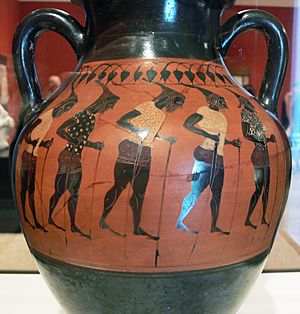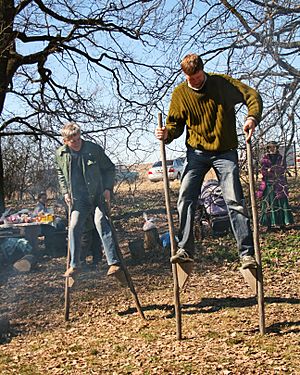Stilts facts for kids
Stilts are like tall poles or posts that help a person or a building stand high above the ground. When people use stilts for walking, they have platforms for their feet. These can be strapped to their legs or held with their hands, depending on the design.
Buildings in places that flood often, or on beaches with shifting sand, are sometimes built on stilts. This helps protect them from water, waves, or moving soil. People have been using stilts for hundreds of years!
Contents
The History of Stilt Walking
Old ruins and writings show that people walked on stilts in Ancient Greece as far back as the 6th century BC. Some traditions of using stilts are very old. For example, in Belgium, stilt walkers in a city called Namur have been having fights on stilts since 1411!
People who lived in wet or flooded areas sometimes used stilts for practical reasons. They would use them to work in swamps or rivers.
Shepherds in the Landes region of southern France used stilts to watch their sheep. Standing tall helped them see their flocks better. Townspeople also used stilts to travel across muddy ground in their daily lives.
Stilts Today
You can buy stilts as a fun toy for kids to learn new skills. Stilt walking is often taught in circus workshops at schools, summer fairs, and other events.
Stilts are used a lot in many countries for entertainment. Stilt walkers perform their amazing skills in parades, festivals, and street shows.
In the past, stilt walkers often wore long trousers or skirts to hide the stilts, making them look like very tall people. Now, stilt walkers create all kinds of costumes that don't look like a tall person at all. They might dress as flowers or animals! A new trend is a stilt walker riding a 'stilt bicycle'. This is usually a regular bike with a very tall seat and handlebars.
Farmers in California use special aluminium stilts to pick fruit from tall peach, plum, and apricot trees. Stilts are also used for washing large windows or fixing thatched roofs. People use them to install or paint high ceilings. In construction, stilts help workers put up drywall, do finish painting, and hang ceiling tiles.
Different Kinds of Stilts
Stilts can be used for fun, as a tool for work, or as part of a hobby.
- Hand-held stilts: These are often used as toys for kids and in circus workshops. There are two main types: string and can/bucket stilts, and pole stilts. Unlike other stilts, hand-held stilts are not tied to the person wearing them.
- Peg stilts: Also called Chinese stilts, these are popular with professional performers. They strap onto your foot, ankle, and just below your knee. Peg stilts are often made of wood, but can also be made from aluminium or steel. These stilts are very light. They let a person walk fast, turn quickly, and even jump rope or dance! The stilt walker must keep moving to stay balanced.
- Drywall or Dura stilts: These stilts are made so the stilt walker can stand still or walk. They were first designed for people working at a higher level, like when putting up drywall or plasterboard, or painting.
- Spring stilts: These stilts have springs that let the user run, jump, and do cool acrobatic moves. Spring stilts were first patented in the United States in 2004. They are sold for fun and for extreme sports.
- Digitigrade stilts: This type of peg stilt follows the line of the foot, not the shin bone. This helps people in costumes look like certain animals.
- Articulated stilts: These are like drywall stilts because they let the stilt walker stand in one place without shifting their weight. These stilts are often used in theme parks.
Amazing Stilt Walking Records
- In 1891, Sylvain Dornon, a stilt walker from the Landes region of France, walked from Paris to Moscow in 58 days!
- On October 1, 2001, Saimaiti Yiming from China walked 79.6 kilometers (about 49.5 miles) on 73-centimeter (about 2.4-foot) stilts in 24 hours. This happened in Shanshan County, China.
- On November 15, 2006, Saimaiti Yiming from China took 10 steps on stilts that were 16.41 meters (about 53.8 feet) high. This broke the Guinness World Record for walking on the tallest stilts.
- In 2008, Roy Maloy from Australia took 5 steps on stilts that were 17 meters (about 55.8 feet) high. This is an unofficial record for the tallest stilts.
- On March 30, 2008, Ashrita Furman from the US ran 1 mile (1.6 kilometers) in 7 minutes and 13 seconds on spring stilts in Germany.
Chickee Huts: Houses on Stilts
A chickee (pronounced "CHICK-ee") is a type of shelter supported by posts. It has a raised floor, a roof made of thatch (like dried leaves), and open sides. The word "chickee" means "house" in the languages spoken by the Seminole and Miccosukee Native American tribes. Chickees are also known as chickee huts or stilt houses.
Chickees were used for cooking, sleeping, and eating.
Today, chickees are still used by Native American villages of the Miccosukee in the Everglades. Some fancy homes in southern Florida even have chickee-style buildings in their gardens or by their pools. A few restaurants in Florida also use this unique design to attract visitors.
Chickees are also used in the wild areas of Everglades National Park. They are especially helpful where wet lands or mangrove trees make it hard to camp on dry ground. These wooden structures stand several feet above the water. They can usually hold four to five campers and have portable restrooms. Some "double chickees" are connected by a walkway and can hold eight to ten people.
Chickees are very useful, especially when it rains!
Images for kids
-
The Royal Merchtem Stilt Walkers
See also
 In Spanish: Zanco para niños
In Spanish: Zanco para niños



















